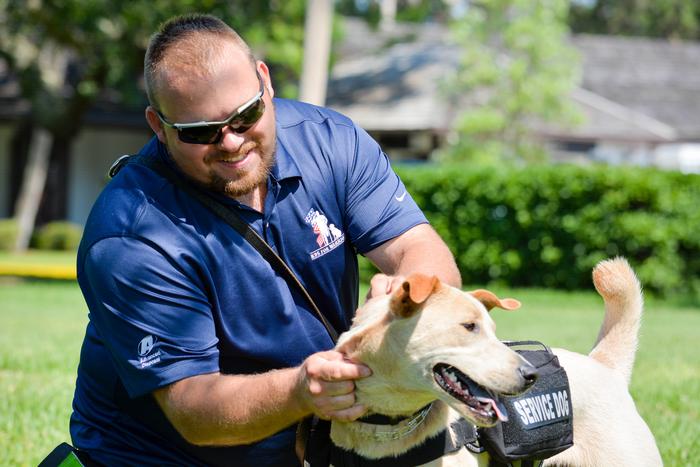Ret. Command Sgt. Maj. Gretchen Evans served in the United States Army for 27 years until a rocket blast in Afghanistan brought her career to an abrupt end in 2006. At just 46 years old, Evans was left with near-total hearing loss, a traumatic brain injury and post-traumatic stress disorder.

Credit: K9s For Warriors
Ret. Command Sgt. Maj. Gretchen Evans served in the United States Army for 27 years until a rocket blast in Afghanistan brought her career to an abrupt end in 2006. At just 46 years old, Evans was left with near-total hearing loss, a traumatic brain injury and post-traumatic stress disorder.
After more than a year of rehabilitation, she struggled to find a new identity.
“It was a devastating shock to me,” Evans said. “I lost my career, my passion and purpose. In the beginning, it was a very rough transition, not just from the military to civilian world, but overcoming these injuries. I struggled with employment. I struggled connecting with other people. I fell into a very lonely depressive state.”
Relief finally came in the form of a service dog named Aura, a black labrador retriever with “lovable brown eyes” with whom Evans was paired in 2015. Evans retired her four-legged friend to a more domestic life in her home five years later – at which time she was paired with her second dog, a golden retriever and black lab mix she likes to call “Rambunctious Rusty.”
Whether at home or on the road, Aura and Rusty alert Evans to people behind her and different noises such as doorbells, alarms or family members trying to get her attention. The dogs even allowed Evans to get back behind the wheel of a car, as they can alert and point in the direction of sounds like emergency vehicles.
“As soon as I got Aura and had her by my side, that really took away the fear of engaging with people and day-to-day life,” Evans said. “I didn’t feel like a Deaf person anymore. I had working ears; they just so happened to have four legs and black fur. Aura opened so many doors and gave me my confidence back. And I was never lonely, because those dogs are your best battle buddy in the world.”
Improved patient outcomes
The benefits of service dogs for veterans with post-traumatic stress disorder are well documented in personal stories like Evans’, but there is a lack of empirical research on the use of the animals as a medical intervention.
Researchers at the University of Arizona College of Veterinary Medicine have taken a step toward improving better understanding the relationship, which they believe could lead to life-changing improvements in health care for veterans.
When compared to the control group, veterans in the study who worked with service dogs experienced significantly lower self-reported and clinician-rated PTSD symptom severity, lower anxiety and depression, a significantly higher quality of life and fewer feelings of isolation. Veterans working with service dogs also had a 66% lower odds of receiving a PTSD diagnosis from a mental health professional after three months with a dog.
The researchers, whose work is published in the medical journal JAMA Network Open, wanted to better understand how living and working with service dogs impacts PTSD symptoms, depression, anxiety and psychosocial functioning among veterans already receiving traditional medical care.
The lack of data on service dogs as medical care leads to a series of challenges for veterans seeking treatment, said lead study author Sarah Leighton, a graduate student studying psychology and a member of the OHAIRE research group in the College of Veterinary Medicine.
Those challenges include limited funding for service dog nonprofits that rely on donations, medical insurance companies that do not fund service dog intervention, and legislative gaps in terms of protecting the civil rights of people with disabilities partnered with service dogs.
“We know that veterans with PTSD are struggling,” Leighton said. “Rates of death by suicide among veterans with PTSD are about one-and-a half times higher than civilian adults, and they also have very high rates of other conditions like depression and anxiety. We’re really seeking to identify complementary interventions that can support veterans with PTSD, and hopefully improve their outcomes.”
According to the U.S. Department of Veterans Affairs, post-traumatic stress disorder is a mental health problem some people develop “after experiencing or witnessing a life-threatening or traumatic event” and is slightly more common in veterans than in the general population. The number of veterans with PTSD varies by demographic, service era and available data, but The National Library of Medicine concludes that upwards of 23% of veterans experience PTSD during their lifetime. Symptoms can include flashbacks, nightmares and panic attacks. Suicide and suicidal ideations are also closely linked to PTSD. A 2020 study by the Department of Veterans Affairs found the rate of suicide among veterans is nearly double that of the civilian population.
Service dogs are trained to perform tasks that help those with disabilities, and their training can be tailored to different circumstances. For a veteran with PTSD, a service dog may retrieve medication or perform anxiety-relieving actions like nuzzling or leaning against a person when the dog senses a heightened state of anxiety.
To find out whether working with a service dog can impact medical outcomes, Leighton and her colleagues recruited 156 veterans on a waiting list for a service dog through K9s For Warriors, a national nonprofit that specializes in service dog care, training and interaction. Of that group, 81 participants were partnered with service dogs at no cost while the rest remained on a waiting list.
All participants had regular access to any previous medical treatment, which could range from mainstream interventions like therapy or medication to complementary and integrative health interventions such as acupuncture or meditation. The veterans partnered with service dogs took a three-week, in-person course that included 40 hours per week of instruction in service dog care, training and interaction, as well as written and hands-on testing. Service dogs in the study received an average of six months of expert training and socialization to prepare them for their working role.
Participant wellness was measured at the start of the study and after three months. Participants filled out the PTSD Checklist based on the Diagnostic and Statistical Manual of Mental Disorders, which measures symptom severity. At the same time, medical professionals with no knowledge of the experiment conditions conducted the Clinician-Administered PTSD Scale, also known as CAPS-5, which is used to make a PTSD diagnosis.
Leighton said the results are clear evidence that partnership with a service dog may be a highly effective complementary medical intervention.
“We are already seeing these significant changes in nearly every area we measured after just three months of service dog partnership,” she said. “In some ways this is remarkable given that, on average, service dog partnerships can last eight or more years. We are seeing that the veterans in the service dog group are having a better quality of life and lower severity of their symptoms. I think that is really powerful.”
The study was led by principal investigator Maggie O’Haire, College of Veterinary Medicine associate dean of research and professor, and founder of the OHAIRE group. O’Haire and Leighton worked alongside Evan Maclean, associate professor and founder and director of the Arizona Canine Cognition Center; Kerri Rodriguez, assistant professor of human-animal interaction and the founder and director of the Human-Animal Bond Lab; Clare Jensen, a research scientist with the OHAIRE group; Erin Asbeck, a biostatistician with the university’s BIO5 Institute; and Edward John Bedrick, a professor in the Department of Epidemiology and Biostatistics at the Mel and Enid Zuckerman College of Public Health.
‘Pawsitive’ healing
While the result of the study supports veterans partnering with service dogs to reduce PTSD symptoms, the researchers say more work must be done to better understand exactly how working with a service dog impacts other treatments for PTSD.
The OHAIRE group is developing a clinical trial that will help with that. O’Haire and her colleagues were recently awarded funding from the Assistant Secretary of Defense for Health Affairs and the Department of Defense for the study, “Psychiatric Service Dogs and Prolonged Exposure Therapy for Military-Connected PTSD.” The researchers were awarded more than $750,000 for a one-year planning phase, with an option to initiate a $7.6 million clinical trial once planning is complete. The study will analyze how service dogs impact the effectiveness of prolonged exposure therapy, which O’Haire called “gold-standard” therapy recommended to treat post-traumatic stress disorder. In prolonged exposure therapy, individuals gradually approach trauma-related issues and feelings, confront fear-inducing stimuli, and learn to cope with negative emotions.
“The impact of service dogs on existing PTSD care is unknown,” O’Haire said. “We have amazing, frontline, evidence-based treatments that can and will help veterans with their PTSD. The issue is that many of these treatments – including the best ones – are difficult and veterans often drop out or do not complete them because they are stressful and challenging. The idea inspiring this project is that a service dog could help alleviate some of these challenges, increase retention and motivation, and get people through a treatment that can work.”
During the planning phase, researchers will work with experts in PTSD research, both at the VA and UArizona, to understand how to integrate service dogs into prolonged exposure therapy in the most safe and efficient way possible and to design a large-scale, randomized trial. The year-long planning phase is expected to begin this fall. If approved, the study would begin in 2025 and enroll 216 veterans – half of whom would work with a service dog.
Specifically, researchers hope to discover if working with a service dog during therapy leads to fewer trauma symptoms and less severe PTSD, less suicidal thinking, better biological, physiological and social well-being and an easier time completing prolonged exposure therapy.
“We are expanding our studies to learn from a broader group and to obtain more detailed information that can improve this practice for both humans and dogs,” O’Haire said. “Veterans have told us directly that our research is changing their lives for the better. Service dog partnerships deserve to be researched, and our findings will help increase access for people who could benefit.”
Journal
JAMA
DOI
10.1001/jamanetworkopen.2024.14686
Subject of Research
Animals
Article Title
Service Dogs for Veterans and Military Members With Posttraumatic Stress Disorder
Article Publication Date
4-Jun-2024




